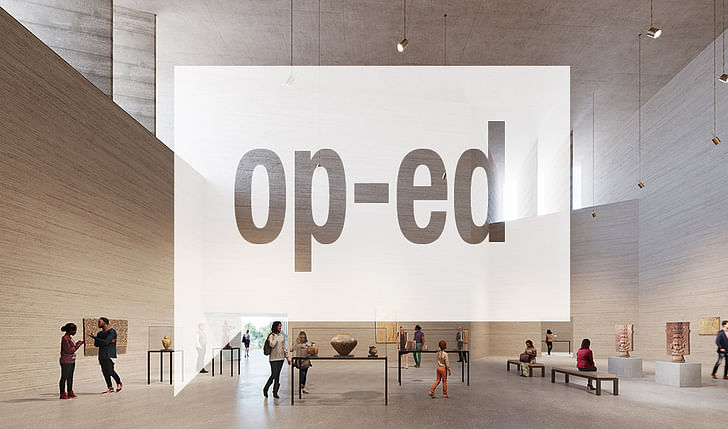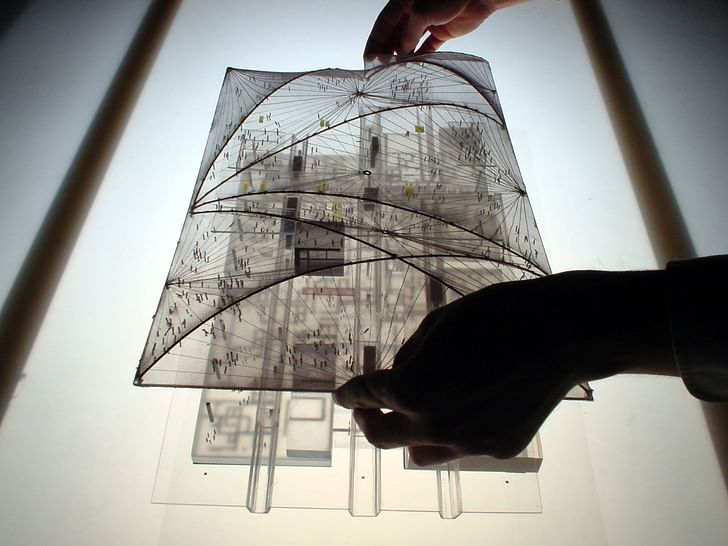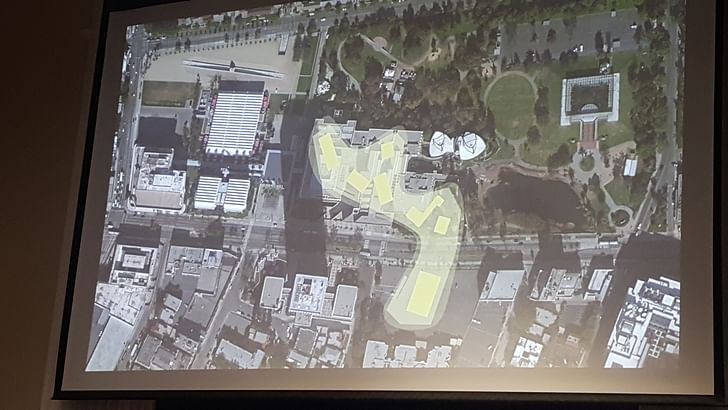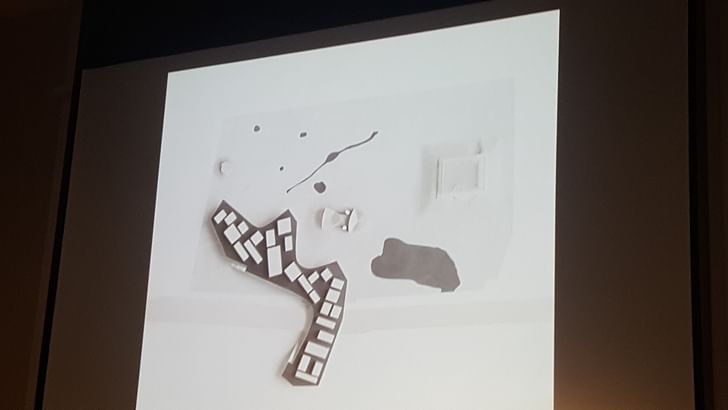

Despite vocal critical and popular outcry, Atelier Peter Zumthor's controversial Los Angeles County Museum of Art replacement project is moving full-steam ahead and is due to begin construction imminently.
LACMA Director Michael Govan recently sat in conversation with University of Southern California School of Architecture Dean Milton Curry to discuss his plans for the new museum. The plan, derided for offering less exhibition space than the current museum in an uninspiring "blob" building that some have liked to a coffee table, has prompted much head-scratching from the design community, which has shown a surprisingly reverence for the existing William L. Pereira & Associates-designed museum complex.
In an Op-Ed, architect John Southern summarizes and reflects upon the discussion between Govan and Curry and ponders if the success of the museum project signals that "L.A. has stopped being the city that dares to dream and take architecture to the limits of rationality."
On Wednesday, August 28th, I spent a very informative evening at the University of Southern California School of Architecture listening to USC Architecture dean Milton Curry and Los Angeles County Museum of Art (LACMA) director Michael Govan discuss the new LACMA building design by Peter Zumthor. I have admittedly given Zumthor’s proposal a tepid reception, largely because of my love of the original William Pereira-designed campus of buildings. There are few museums in the world with such porosity and the act of ducking in an out of the various galleries and into the Southern California sun is unique and should be preserved. Sure they’re a wreck, but I had always hoped one of L.A.’s own platinum group of architects might rush in with a credible proposal that favored adaptive reuse. I’d also heard several interviews with Govan regarding the new design, and walked into Harris Hall hoping that the evening would deliver some positive insights into the proposed concept and persuade me that the new museum isn’t going to be a banal brick of culture, hovering menacingly over the La Brea Tar Pits and Wilshire Boulevard.

Govan had the charming conviction and gritty tenacity of a World War II bomber pilot dropping in for a bombing run in the midst of enemy territory, where annihilating the target is paramount over making it home to base. Now that the project has been fully funded and approved by the L.A. County Board of Supervisors, he has no one left to convince, but I speculated that being in a room full of architects and historians might have led him to be more on-point than usual. With Dean Curry deftly leading the dialogue, we in the audience were treated to what amounted to the most complete explanation of the proposed LACMA design that I have heard to date. Here are some of the things I learned.
Initially, Govan was interested in exploring the possibility of building OMA's proposal from 2001. The Los Angeles County Board of Supervisors, however, was not, largely, one can guess, due to Rem Koolhaas’s purported comment that the tent structure that was central to the design would possibly need to be replaced every five years. What Govan retained from examining the proposal was that “the encyclopedic museum” was dead, and that LACMA’s new home, no matter who designed it, should reflect this fact.

After a detailed cost analysis, the Pereira-designed 1965 complex was deemed too expensive to retrofit and renovate, though Govan says a team exhaustively explored that option. The County also said they would give no money toward rehabilitation, and anyone who has read Deyan Sudjic’s Edifice Complex would agree that donors to the museum were likely lukewarm on the idea that their names and funding would be attached to a reno-job.
And so, Govan and his team of curators set their course toward total demolition of the Pereira-designed campus, and Zumthor was hired.

Govan was clear that the current museum has trouble attracting visitors to the upper levels in many of the galleries and that the low statistics of “clicks” at the uppermost gallery entrances demonstrates that the museum should occupy one level. Paleontological restrictions placed on the site led the design team toward an elevated scheme. The building also sits on a ”Level V” methane zone, and so minimizing its contact with the ground is a safety consideration as well, though several other structures in the area have mitigated this problem through venting systems and specially designed retaining walls and foundations. It was also decided that in order to recapture the lost square footage, the museum should also span Wilshire, thereby adding to the iconic nature of the project, and in the process ruining a vista that those of us who occasionally cruise the boulevard in search of a Sunday sunset consider sacred.
The blob form arose out of the exercise of Zumthor’s office plotting points that were based on “no-go” zones because of their proximity to present and future archeological sites supervised by the L.A. County Museum of Natural History. Zumthor apparently had nails driven into these points and then wove a rubber band around them, thereby producing an organic form that has earned several derisive nicknames from local critics of the project; many of them not mentionable in
The glazing and concrete central to the museum’s aesthetic will, in Govan’s mind, aid in the production of a 21st Century museum. White gypsum board walls are only a recent addition to museums, he stated, and their objective aesthetic presence represents an overtly narrow method for presenting art, hence why the walls will be concrete. The glass facade on the exterior will connect museum goers to the surrounding city, as well as exploit their presence as a voyeuristic exhibition to motorists stuck in rush hour traffic on Wilshire Boulevard below. Galleries will be layered so that sun loving art can be appreciated, while moderately sensitive pieces will occupy the next series of internal spaces, which contain direct connections to the promenade beyond. Art that cannot be exposed to light will dwell in the central galleries sheltered by the other layers. The most interesting component will be the ability of the museum visitor to wander in and out of time-scales of art history and the cultures that made it, since the curatorial territories will present themselves more as a weave, than as segregated blocks of art.

There was a lot more convincing and pragmatic evidence presented, and all of it led toward the construction of the current proposal, which Govan is obviously very bullish about. For me, as a fan of the current campus, I wished I could’ve dug in my heels and continued in my total disdain for Peter Zumthor’s “black smudge,” which will likely join the hodge-podge of early 21st Century architecture within the next five years (that is if trade wars and tariffs don’t inflate the project budget beyond feasibility during construction). However, I’m convinced that at least it will work as a kind of O.K. space for art. It just won’t be one I appreciate with the same relish.
I got the chance to talk with Michael Govan afterward and learned that Zumthor had indeed proposed a campus scheme that embraced the original museum parti, but that it was discarded because of the operational expense caused by having so many entrances (Govan can tell you exactly how many on a dime, which is why he's director), as well as the desire for the Natural History Museum to reclaim some of its paleontological territory. Confined by various players and site conditions, the museum had no choice but to go up.
I also learned that the in-fighting among different curatorial departments ultimately was avoided by putting the collection into the single-story field condition, where no one department has dominance or a fixed space. Apparently, curators have a "mine is bigger than yours" issue. The interesting data Govan presented that convinced me however, was that based on their visitor numbers. According to him, it didn't matter if the work was a Degas or a dynastic vase from China—visitors just didn't like level changes, and this was reflected in the "clicks" (those security guards are really watching you) that track visitor counts to the museum's different galleries, collections, and buildings.

The current proposal, with its easily controlled entry points and mechanized circulation systems will cut down on the amount of security required (my understanding of Govans inference during our conversation). Apparently the existing museum is a big problem with regard to staffing and security because of its porosity. I will miss this, and I told Govan as much, but he insisted that the whole campus (I was just talking about LACMA since that's what is being demolished), would preserve that feel and that a long external promenade would give respite on crowded days. I don't agree, but I understand the operational costs in having a museum whose galleries can be easily accessed by the public, paying and otherwise, might be a problem with the bottom line.
In the end the new museum will be a success for visitors and tourists who are comfortable with large, homogeneous global museum spaces. Govan believes that the campus vibe will be maintained—largely because of the new museum's relationship to all the other objects on the field. Donors will glide like swans on the exterior promenade during fundraising events, and will also likely bake like bread in an oven on L.A.’s notoriously scalding summer afternoons. There are lots of cool technological aspects integrated into the design that resolve a lot of the sniping from critics and will add authenticity to the museum's interior. There are even drapes, designed in collaboration with an artist, and “yes,” the acoustical issue that comes with a museum made out of hard surfaces apparently has been figured out. But there was little soul in the renderings shown during his presentation, a point which Govan seems to be painfully aware of, since he mentioned several times how much he hates architectural renderings.
While it was a remarkably informative evening, Govan’s discussion with Dean Curry was a sad reckoning for me in that I realized that L.A. has stopped being the city that dares to dream and take architecture to the limits of rationality. Gone is the messy urbanism that gives birth to an art acropolis hovering over a lake of methane, and with it a challenge to the status quo (architecturally speaking, anyway). I believe that we have entered L.A.'s post-rational period, where cultural institutions are governed by bean counters, lawyers, and social media marketeers, and where the chaos of the growling metropolis has been caged in a concrete pen—appealing only to the Instagram crowd who will continue to blithely occupy Chris Burden's Urban Light in their fleeting attempts to remain immortal.
I am impressed with Govan and his team of donors, curatorial advisors, and staff when I consider them in the same vein as a group of film producers. Like many in Hollywood, they looked at the odds, and picked the surest win, rather than betting the farm on something socially dynamic and spatially provocative. His ability to deftly navigate the political landscape of L.A. is quite admirable as well, and the new museum will be a box-office hit with its staff, the media-savvy public, and donors alike.
Based on my conversation with Govan, I accept that Zumthor has examined all the possibilities of the site (I do wish they'd been more transparent with the process). But, I left feeling defeated, knowing that my fond memories of Pereira's majestic barge of messy SoCal urbanism will truly be gone and all that awaits us is a queue for the escalator or the gift shop.
Urban Operations is a Los Angeles-based architecture and research firm founded by architect John Southern in 2005.The studio specializes in design/build work and research projects that seek to expand critical discourse within the design profession. Through its research division, Urbanops.org, the ...
1 Featured Comment
This is a wonderful article and it summarizes my feelings of the project. For a reality check of the determinants reread the article and then go to the Getty and meditate...even the Broad or SFMOMA would also work.
In the end the success of the new museum will depend on:
The quality of its permanent collection
The number of first class traveling exhibitions
The museum “experience”
Eventually the architecture will matter less....but as a past 20 year resident of the Park La Brea towers and bungalows I had hoped for a better solution, or, at least, to be the recipient of the window washing contract.
All 9 Comments
Nowhere have I seen an explanation as to why LACMA is building a museum with less square footage than there is in the current complex. That seems counterintuitive to me. Does LACMA plan to stop making new acquisitions?
Yikes, what's up with that "David Geffen Galleries" signage? Tacky as hell... ruins the entire thing.
The incremental cost of adding a second or even third level would seem small, and allow for expanding collections. The "click" rate argument seems weak. Some collections will be less visited. Nothing wrong with that. Value in the long tail.
The "branded entry", aka signage is astonishingly bad. I'm sure Geffen told Govan that the letters had to be a certain (big) height. I'm surprised Zumthor is ok with it.
Govan's interests seem to lie mainly with maximizing attendance, donor recognition, publicity, and sales. The quality and quantity of gallery space and museum programming is an afterthought. A smaller LACMA with less art on display will be cheaper to operate, require less staff, and puts curatorial department heads in their (subservient to Govan) place.
I don't see what was so wrong about spanning over the tar pits. Also, take the horizontal architecture back to black and keep the rest tan. Done and done.
Also: OMA's 2001 proposal was controversial in that it wasn't good. Which is supposing since most of their stuff in that era was A+.... sometimes you just don't have it.
I'm not terribly interested in this project but when I feel stressed I watch the video of Brad Pitt defending it in front of the LA County Board of Supervisors hearing and I relax.
This is a wonderful article and it summarizes my feelings of the project. For a reality check of the determinants reread the article and then go to the Getty and meditate...even the Broad or SFMOMA would also work.
In the end the success of the new museum will depend on:
The quality of its permanent collection
The number of first class traveling exhibitions
The museum “experience”
Eventually the architecture will matter less....but as a past 20 year resident of the Park La Brea towers and bungalows I had hoped for a better solution, or, at least, to be the recipient of the window washing contract.
So this is really all about ego, Govan's even more than Zumthor's.
It's not a museum but an event space. That's not necessarily a criticism, but I'm curious to see how this plays out. I'm guessing it will be popular, but if it isn't or interest dies out? I wonder how much the mighty clicker will determine what is shown.
You see in the Louvre what LA is trying to avoid, and this gives pause. The openness and spaced hangings may well play make the experience tolerable, even enjoyable.
Necessarily, however, significant sacrifices will be made in how much is shown, and much will be in storage.
Block this user
Are you sure you want to block this user and hide all related comments throughout the site?
Archinect
This is your first comment on Archinect. Your comment will be visible once approved.